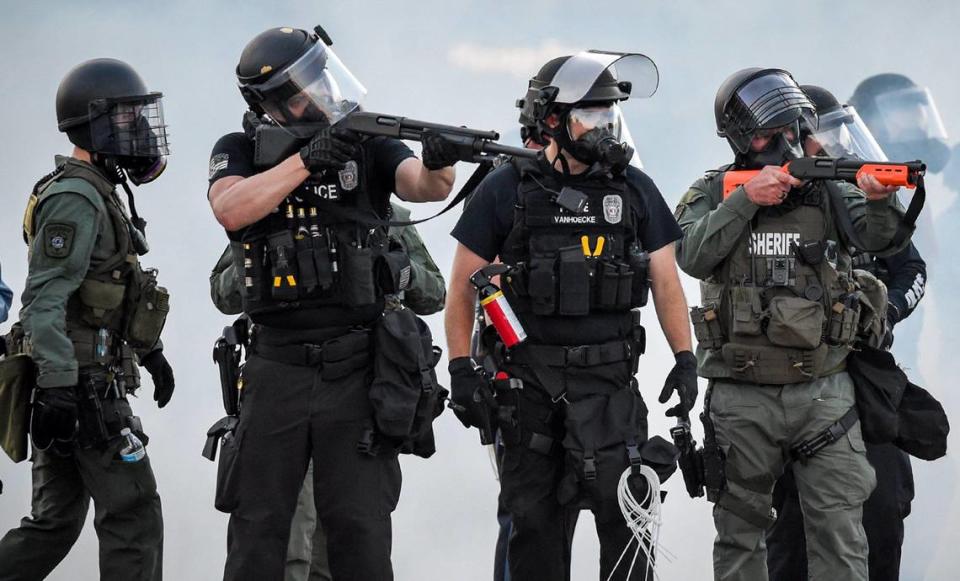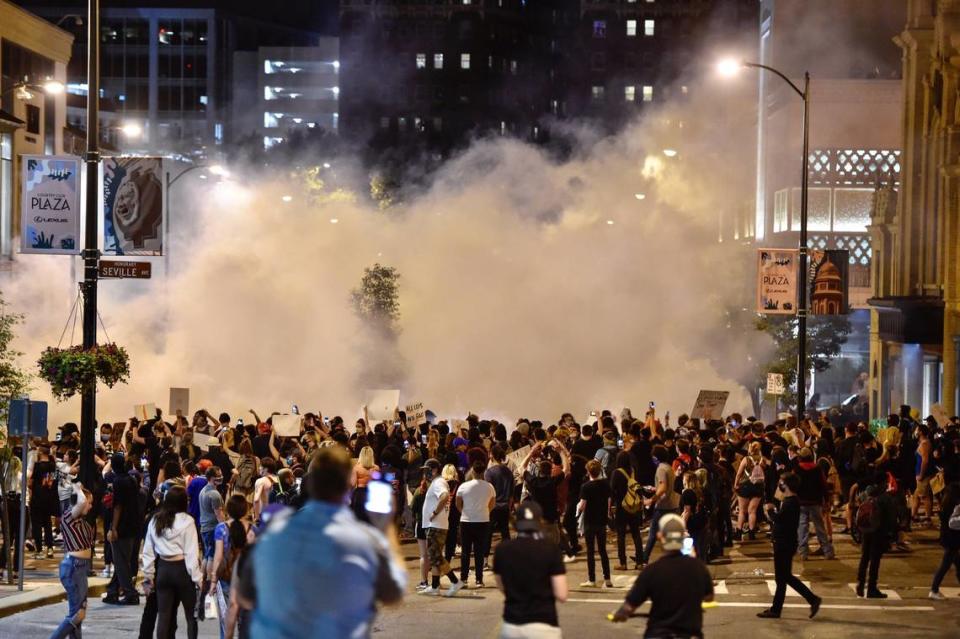Kansas City police used tear gas, other types of force over 130 times at Plaza protests
The sharp gasps that came with each inhalation, the coughing and the burning skin sensation wore off within hours.
But the sting of the Kansas City Police Department’s tear gas at the summer 2020 protests at The Plaza is still an open wound for Kansas City activist Justice Horn, who described feeling like he was enveloped in a “dry heat.”
Data newly obtained by The Star shows the police department used force more than 130 times over four days starting May 29, 2020, as rage swept across the nation in the wake of George Floyd’s murder by a police officer in Minneapolis.
“They came out there ready to fight a war and we came out and were ready to protest for the injustice that is the taking of Black lives in our country,” said Horn, who is running for a seat in the Jackson County Legislature.
The records reveal the police used pepper spray nearly 75 times and fired bean bag rounds 33 times. They also used less lethal projectiles, tear gas and a baton on protesters.

The Star obtained the police department’s data through a public records request. Those records show that police use force against Black people at a disproportionate rate: from 2019 to July 2021, more than 57% of the incidents were on Black people, who make up 28% of the city.
That disparity was less prominent but still apparent in the force used during the protests, when 40% of the encounters where race was listed were on Black people.
The police department’s data is the fullest account of the use of force that unfolded, though still incomplete.
Four days of protests
Maj. Mike Wood, a special operations commander oversaw the protests, according to the police department, which declined to make him available for an interview. The first day, records show police used pepper spray 10 times and no other types of force.
Hundreds came out the next two days, carrying signs about police brutality, chanting for justice and marching throughout the streets. Force was used more than 100 times and escalated to tear gas, bean bag rounds and other less lethal projectiles.
On June 1, there were far fewer incidents recorded at 12, but of those, nine were bean bag rounds or less lethal projectiles. A baton was also used after an officer was pushed.
While most of the protests were peaceful, police reported that protesters hurled water bottles, rocks and canned food at them, provoking them to return with force.
The department’s records also show protesters threw tear gas canisters back towards officers 11 times. But there were only two entries for officers deploying the canisters in the first place.
Sgt. Jake Becchina, a spokesman for the police department, said officers from outside agencies who responded to the protests deployed tear gas, which would not be reflected in their records. Citing pending litigation, the department declined to comment further.
Lora McDonald, executive director of MORE2, a social justice organization, said it was not right that the department could call in reinforcements, “but then there’s no accountability of what happened.”
Accountability is necessary for healing to begin, Horn said.
“There needs to be accountability today and the data justifies what exactly their operation looked like.”

Unrest prompts changes
The aftermath of the protests led to lawsuits, criminal charges on an officer and changes in the police department’s policies.
A case filed by a man injured by a tear gas canister was settled last year for $200,000 while another lawsuit, filed by a man who lost vision in one of his eyes after he was hit by a projectile, is ongoing.
The protests also resulted in an officer being charged after allegedly pepper spraying a man and his teenage daughter. Officer Nicholas McQuillen faces one count of misdemeanor assault and is scheduled to go to trial April 11. Last week, the police department agreed to a $110,000 settlement to the teen.
The department also implemented a new “First Amendment” policy. Issued in April 2021, the policy directs officers to minimize displays of force like armored vehicles and prohibits less lethal munitions from being used to disperse crowds, though pepper spray is still allowed.
Chief Rick Smith said in a blog post that the changes were in response to reform requested by the community.
“We are here to support and protect the exercise of First Amendment rights,” he wrote.
The protests also led to other significant changes with how the police department operates: officers are now outfitted with body cameras and police shootings are investigated by an outside agency.
See where police used force during the summer 2020 protests in Kansas City
Data obtained by The Star shows the police department used force more than 130 times over four days starting May 29, 2020. Zoom in and click on the dots for more information.

